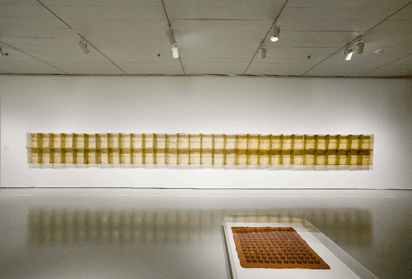Reassembling the legacy of Eva Hesse
Eva Hesse’s career was all too brief, from about 1963 to 1970—the year she died of a brain tumor at the age of 34. Her innovative, eccentric sculptural forms made of latex, rope, and fiberglass had an uncanny power that quickly brought her to prominence. Drawing played a crucial role in the development of her sculpture, but exactly how is still a matter of critical debate. Until this year, Hesse’s work hadn’t been featured in depth at a New York venue since 1972—even though she’s considered to be one of the great ‘60s artists.
Like a rare eclipse, overlapping exhibitions of Hesse’s sculpture and drawings suddenly make her finest work in both disciplines visible. Uptown at The Jewish Museum, a beautiful display of the sculpture is on view, supplemented by fascinating biographical material and two films of the artist at work. Downtown at The Drawing Center, her drawings are complemented by fine sculptural studies. Both exhibitions are indispensable to an overdue reconsideration of Hesse’s work in light of its lasting influence upon contemporary art.
The Jewish Museum endeavored to recreate part of Hesse’s last solo exhibition, entitled “Chain Polymers,” which took place at Fischbach Gallery on West 57th Street in 1968. This visionary curatorial ambition was a daunting task. For example, the five multipart wall-mounted units of “Sans II” had to be borrowed from worldwide museum collections and reassembled on one very long wall.
Why they were separated in the first place is a good question. One has to see the whole absurd length of “Sans II” to understand that the repetition of its wavy fiberglass units relates to the chain polymer concept of the exhibition’s title. Despite the chemically engineered sound of the term polymer, it describes the molecular structure of materials as ordinary as paper, cotton, and latex. Polymers can also be created in the lab. Nylon and fiberglass are polymers. Whether organic or inorganic, a polymer’s molecules are linked together as a chain of identical repeating units. Their stringy form and tendency to entangle is reflected in a number of the artist’s sculptures, as well.
Hesse’s access to concepts such as the chain polymer may well have come through art and science seminars given by the organization Experiments in Art and Technology, or E.A.T. (A mimeographed page from an E.A.T. seminar bearing her penciled notes is on view at The Jewish Museum.) E.A.T. was the brainchild of Robert Rauschenberg and IBM engineers. Its seminars were hugely popular with artists and performers.
In fact, the aesthetic conversation of Minimalist performance art can also be traced in Hesse’s oeuvre. Sculptors and dancers alike were using rigging and principles of seriality. The Jewish Museum displays “Accretion,” a work in which 50 luminous fiberglass tubes lean upright against the wall and each other, looking much like a troupe of dancers stretching at the barre. Also on view is Hesse’s extraordinary rope piece “Untitled” from 1970. Latex-soaked, suspended, and entangled, it’s part fetish, part 3-D Pollock painting, and part polymer molecule.
Hesse recognized the evanescent materiality of latex as well as its evocation of the body. By the late 1960s, she knew that she was dying of brain cancer. The ephemerality of Hesse’s work is linked to its insistent absurdity, which holds onto life even while being sucked into oblivion.
gaycitynews.com



































